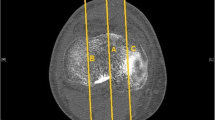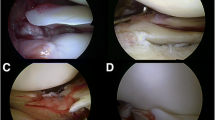Abstract
Knowing the relationship between diagnoses is important in knee arthroscopy in terms of defining possible treatment modalities preoperatively. The purpose of our study was to define the diagnoses made intraoperatively through knee arthroscopy and the relationships between them. We evaluated the results of knee arthroscopies performed over a 10-year period. The sites and sizes of chondral lesions, the existence of anterior cruciate ligament (ACL) injury, and the sites of meniscal lesions were noted for a total of 1,774 patients. The relationships between these lesions were evaluated statistically. Chondral lesions and posterior medial meniscal tears were predominant in females, whereas complete ACL tears were predominant in males. ACL tears were commonly accompanied by medial and lateral meniscal bucket-handle tears. In cases with advanced chondral lesions, medial and lateral posterior meniscal and lateral anterior meniscal tears were more common. According to our results, posterior tears of the medial menisci, medial and lateral femoral condyles, lateral tibial plateau type 3 or 4 cartilage lesions, and the rate of diagnostic arthroscopy were higher in females, while middle substance and bucket-handle tears of medial menisci and total rupture of the ACL were more common in males. ACL injuries were seen to coexist with medial or lateral menisci bucket-handle tears, with no relationship between the site or size of the chondral lesions. A relationship between medial and lateral meniscal tears and the site of femoral and tibial chondral surface lesions was detected.
Similar content being viewed by others
References
Parsons S, Breen A, Foster NE, Letley L, Pincus T, Vogel S, Underwood M (2007) Prevalence and comparative troublesomeness by age of musculoskeletal pain in different body locations. Fam Pract 24:308–316
Suka M, Yoshida K (2005) Musculoskeletal pain in Japan: prevalence and interference with daily activities. Mod Rheumatol 15:41–47
Figueroa D, Calvo R, Vaisman A, Carrasco MA, Moraga C, Delgado I (2007) Knee chondral lesions: incidence and correlation between arthroscopic and magnetic resonance findings. Arthroscopy 23:312–315
Khanda GE, Akhtar W, Ahsan H, Ahmad N (2008) Assessment of menisci and ligamentous injuries of the knee on magnetic resonance imaging: correlation with arthroscopy. J Pak Med Assoc 58:537–540
Sampson MJ, Jackson MP, Moran CJ, Moran R, Eustace SJ, Shine S (2008) Three tesla MRI for the diagnosis of meniscal and anterior cruciate ligament pathology: a comparison to arthroscopic findings. Clin Radiol 63:1106–1111
Prodromos CC, Han Y, Rogowski J, Joyce B, Shi K (2007) A meta-analysis of the incidence of anterior cruciate ligament tears as a function of gender, sport, and a knee injury-reduction regimen. Arthroscopy 23:1320–1325
Lubetzky-Vilnai A, Carmeli E, Katz-Leurer M (2009) Prevalence of injuries among young adults in sport centers: relation to the type and pattern of activity. Scand J Med Sci Sports 19(6):828–833
Muraki S, Akune T, Oka H, Mabuchi A, En-Yo Y, Yoshida M, Saika A, Nakamura K, Kawaguchi H, Yoshimura N (2009) Association of occupational activity with radiographic knee osteoarthritis and lumbar spondylosis in elderly patients of population-based cohorts: a large-scale population-based study. Arthritis Rheum 61:779–786
Maravic M, Landais P (2006) Usefulness of a national hospital database to evaluate the burden of primary joint replacement for coxarthrosis and gonarthrosis in patients aged over 40 years. Osteoarthr Cartil 14:612–615
Blagojevic M, Jinks C, Jeffery A, Jordan KP (2010) Risk factors for onset of osteoarthritis of the knee in older adults: a systematic review and meta-analysis. Osteoarthr Cartil 18(1):24–33
Iwamoto J, Takeda T, Sato Y, Matsumoto H (2008) Retrospective case evaluation of gender differences in sports injuries in a Japanese sports medicine clinic. Gend Med 5:405–414
Nutton RW (2009) Is arthroscopic surgery a beneficial treatment for knee osteoarthritis? Nat Clin Pract Rheumatol 5:122–123
Bernstein J, Quach T (2003) A perspective on the study of Moseley et al.: questioning the value of arthroscopic knee surgery for osteoarthritis. Cleve Clin J Med 70:401–410
Fond J, Rodin D, Ahmad S, Nirschl RP (2002) Arthroscopic debridement for the treatment of osteoarthritis of the knee: 2- and 5-year results. Arthroscopy 18:829–834
Moseley JB, O’Malley K, Petersen NJ, Menke TJ, Brody BA, Kuykendall DH, Hollingsworth JC, Ashton CM, Wray NP (2002) A controlled trial of arthroscopic surgery for osteoarthritis of the knee. N Engl J Med 347:81–88
Steadman JR, Briggs KK, Matheny LM, Ellis HB (2013) Ten-year survivorship after knee arthroscopy in patients with Kellgren-Lawrence grade 3 and grade 4 osteoarthritis of the knee. Arthroscopy 29(2):220–225
Spahn G, Hofmann GO, Klinger HM (2013) The effects of arthroscopic joint debridement in the knee osteoarthritis: results of a meta-analysis. Knee Surg Sports Traumatol Arthrosc 21(7):1553–1561
Dervin GF, Stiell IG, Rody K, Grabowski J (2003) Effect of arthroscopic debridement for osteoarthritis of the knee on health-related quality of life. J Bone Joint Surg Am 85:10–19
Granan LP, Bahr R, Lie SA, Engebretsen L (2009) Timing of anterior cruciate ligament reconstructive surgery and risk of cartilage lesions and meniscal tears: a cohort study based on the Norwegian National Knee Ligament Registry. Am J Sports Med 37:955–961
Amin S, Guermazi A, Lavalley MP, Niu J, Clancy M, Hunter DJ, Grigoryan M, Felson DT (2008) Complete anterior cruciate ligament tear and the risk for cartilage loss and progression of symptoms in men and women with knee osteoarthritis. Osteoarthr Cartil 16:897–902
Cohen M, Amaro JT, Ejnisman B, Carvalho RT, Nakano KK, Peccin MS, Teixeira R, Laurino CF, Abdalla RJ (2007) Anterior cruciate ligament reconstruction after 10 to 15 years: association between meniscectomy and osteoarthrosis. Arthroscopy 23:629–634
Vinson EN, Gage JA, Lacy JN (2008) Association of peripheral vertical meniscal tears with anterior cruciate ligament tears. Skeletal Radiol 37:645–651
De Smet AA, Graf BK (1994) Meniscal tears missed on MR imaging: relationship to meniscal tear patterns and anterior cruciate ligament tears. AJR Am J Roentgenol 162:905–911
Yoo JC, Ahn JH, Lee SH, Yoon YC (2009) Increasing incidence of medial meniscal tears in nonoperatively treated anterior cruciate ligament insufficiency patients documented by serial magnetic resonance imaging studies. Am J Sports Med 37(8):1478–1483
Hjelle K, Solheim E, Strand T, Muri R, Brittberg M (2002) Articular cartilage defects in 1,000 knee arthroscopies. Arthroscopy 18:730–734
Widuchowski W, Widuchowski J, Trzaska T (2007) Articular cartilage defects: study of 25,124 knee arthroscopies. Knee 14:177–182
Christoforakis J, Pradhan R, Sanchez-Ballester J, Hunt N, Strachan RK (2005) Is there an association between articular cartilage changes and degenerative meniscus tears? Arthroscopy 21:1366–1369
Slauterbeck JR, Kousa P, Clifton BC, Naud S, Tourville TW, Johnson RJ, Beynnon BD (2009) Geographic mapping of meniscus and cartilage lesions associated with anterior cruciate ligament injuries. J Bone Joint Surg Am 91:2094–2103
Oakley SP, Portek I, Szomor Z, Turnbull A, Murrell GA, Kirkham BW, Lassere MN (2003) Accuracy and reliability of arthroscopic estimates of cartilage lesion size in a plastic knee simulation model. Arthroscopy 19:282–289
Cameron ML, Briggs KK, Steadman JR (2003) Reproducibility and reliability of the outerbridge classification for grading chondral lesions of the knee arthroscopically. Am J Sports Med 31:83–86
Conflict of interest
None.
Author information
Authors and Affiliations
Corresponding author
Rights and permissions
About this article
Cite this article
Unay, K., Akcal, M.A., Gokcen, B. et al. The relationship between intra-articular meniscal, chondral, and ACL lesions: finding from 1,774 knee arthroscopy patients and evaluation by gender. Eur J Orthop Surg Traumatol 24, 1255–1262 (2014). https://doi.org/10.1007/s00590-013-1309-8
Received:
Accepted:
Published:
Issue Date:
DOI: https://doi.org/10.1007/s00590-013-1309-8




